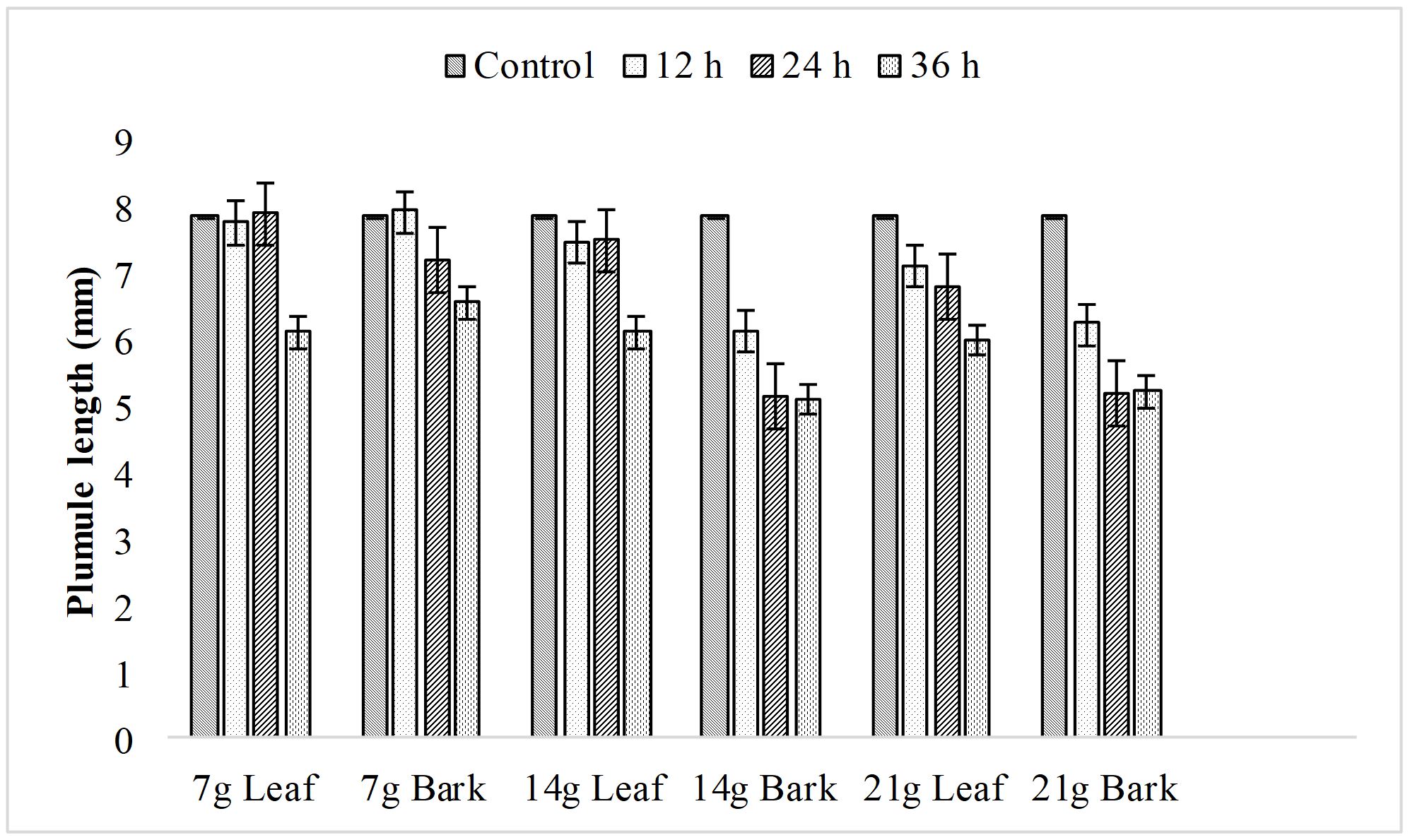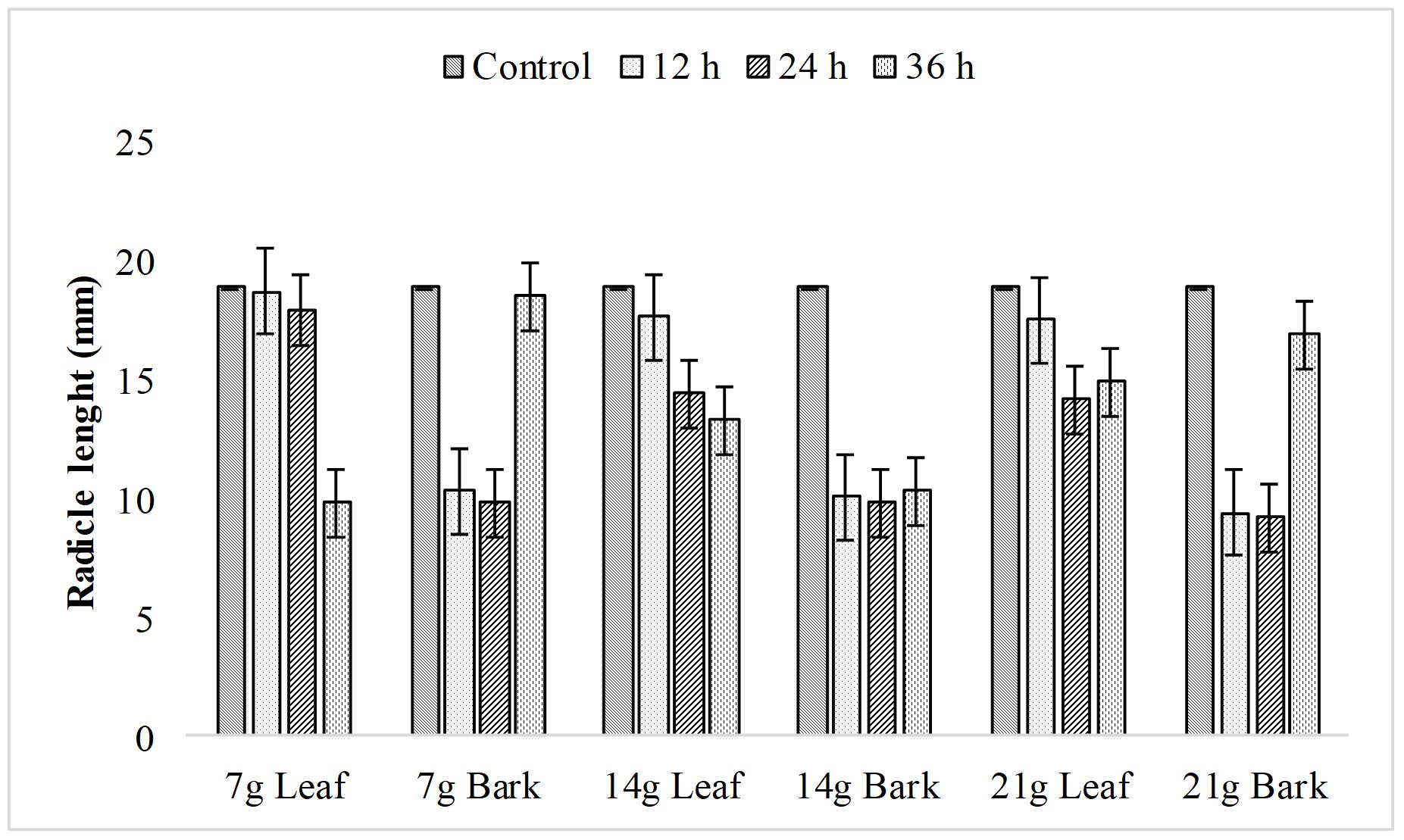S. Siyar, S. Sami, F. Hussain, Z. Hussain
Abstract. Interactions between plants represent an important aspect of ecology, which enables them to properly utilize the available resources in the given environment. The interactions are medi-ated by different mechanisms, among which allelopathy is a significant one. During allelopathic interactions, plants tend to suppress competitors plants or stimulate those which can help them adjust in the environment in a better manner. Such interactions are triggered by the release of chemical compounds termed, as allelochemicals, which have an important role in agricultural modulation. The objective of this experiment was to evaluate the allelopathic effects of leaf and bark extracts of sheesham (Dalbergia sissoo L.) on germination data of wheat (Triticum aestivum L.) cv. Auqab. Different concentrations (7 g/l, 14 g/l, and 21 g/l) of sundried leaf and bark extracts, obtained after 12, 24 and 36 h of soaking duration were tested for germination %, mean germination time (MGT), plumule and radicle length and seedling dry weight. It was observed that germination % was negatively affected by 21 g leaf and bark extract concentration at 36 h soaking duration, but not by lower concentration or soaking durations. MGT was significantly increased by leaf and bark extracts at three concentration levels, as well as soaking durations. Plumule and radicle length responded negatively to both leaf and bark extracts at higher concentration and when soaking duration was increased. Seedling dry weight was increased by 7 g leaf extracts at 36 h, but reduced by 21g at 12 and 24 h soaking durations. On the other hand, 21 g of bark extracts at 12, 24 and 36 h soaking duration resulted in significantly increased dry biomass. These results suggest negative allelopathy of Sheesham on studied germination parameters of wheat, except radicle length and dry biomass.
Keywords: allelopathy; agro-ecosystem; competition; plant interactions; rhizosphere
View full article (HTML)
Allelopathic effects of sheesham extracts on germination and seedling growth of common wheat
S. Siyar1*, S. Sami1, F. Hussain1, Z. Hussain2
1Department of Botany, Qurtuba University of Science and Technology, Peshawar, Khyber Pakhtunkhwa, Pakistan
2Department of Weeds Science, Agricultural University Peshawar, Khyber Pakhtunkhwa, Pakistan
*E-mail: ssiyarbotany@gmail.com
Received: June 22, 2018. Revised: Oct. 21, 2018. Accepted: Nov. 19, 2018. Published online: Oct. 3, 2019
Abstract. Interactions between plants represent an important aspect of ecology, which enables them to properly utilize the available resources in the given environment. The interactions are medi-ated by different mechanisms, among which allelopathy is a significant one. During allelopathic interactions, plants tend to suppress competitors plants or stimulate those which can help them adjust in the environment in a better manner. Such interactions are triggered by the release of chemical compounds termed, as allelochemicals, which have an important role in agricultural modulation. The objective of this experiment was to evaluate the allelopathic effects of leaf and bark extracts of sheesham (Dalbergia sissoo L.) on germination data of wheat (Triticum aestivum L.) cv. Auqab. Different concentrations (7 g/l, 14 g/l, and 21 g/l) of sundried leaf and bark extracts, obtained after 12, 24 and 36 h of soaking duration were tested for germination %, mean germination time (MGT), plumule and radicle length and seedling dry weight. It was observed that germination % was negatively affected by 21 g leaf and bark extract concentration at 36 h soaking duration, but not by lower concentration or soaking durations. MGT was significantly increased by leaf and bark extracts at three concentration levels, as well as soaking durations. Plumule and radicle length responded negatively to both leaf and bark extracts at higher concentration and when soaking duration was increased. Seedling dry weight was increased by 7 g leaf extracts at 36 h, but reduced by 21g at 12 and 24 h soaking durations. On the other hand, 21 g of bark extracts at 12, 24 and 36 h soaking duration resulted in significantly increased dry biomass. These results suggest negative allelopathy of Sheesham on studied germination parameters of wheat, except radicle length and dry biomass.
Keywords: allelopathy; agro-ecosystem; competition; plant interactions; rhizosphere
INTRODUCTION
Wheat (Triticum aestivum L.) in the family Poaceae is an important agronomic crop widely, cultivated for grains, which are used in food and several other processed products. After maize and rice, wheat is ranked the third most widely produced grain crops in the world, which has a significant impact on meeting global food demands and dietary needs (Anonymus, 2014). Wheat is rich in carbohydrates, proteins, and minerals and accounts for 20% of proteins and 21% of calories requirements of more than 4.5 B people throughout the world (Braun et al., 2010). Global wheat production is 630 metric tonnes annually, obtained from approxi-mately 215 million hectares of land (Singh et al., 2011). In Pakistan, it is a major staple food crop, cultivated on an area of about 9.062 MH, with an annual production of approximately 20 metric tonnes (Anonymus, 2014). In 2013, Pakistan was listed as the 9th largest wheat producing country, with output of 24.2 million metric tonnes (Anonymus, 2014).
Still, wheat production in Pakistan is not at par with the increasing population of the country and a gap between production and consumption exists.
Keeping in view the significance of wheat and an increasing demand for its consum-ption, there is a dire need to increase its production by manipulating some novel and eco-friendly approaches in agriculture.
One of the several reasons contributing to lower yields of wheat and other crops is the monoculture pattern practiced in agriculture. Monoculture reduces soil fertility by successively consuming the organic matter and minerals and building up pests and nematodes, which results in a decline of productivity of monoculture crops over time (Narwal, 2000).
Agroforestry and intercropping may overcome soil infertility pro-blems. In agroforestry and intercrop-ping, crops are cultivated under shelter beds of trees or mixed cultivation of different crops are followed, which helps in adding organic matter to soil, improvement of water holding capacity of rhizosphere, biodiversity of microbes, nutrient concentrations and declining pest po-pulation (Narwal, 2000; Ngoran, 2006; Hossain et al., 2011). Furthermore, agroforestry trees release alleloche-micals to rhizosphere, which may establish negative or stimulatory allelopathic interactions with cultiva-ted crops, weeds and microorganisms. Although, all parts of the agroforestry trees may exhibit allelopathy; however, leaves and roots are primary organs, which have strong potential for allelopathic interactions (Narwal, 2000; Majeed et al., 2017).
Allelochemicals released from leaves, roots or other parts of trees may stimulate or inhibit the growth of nearby plants depending on the concentration and nature of allelochemicals and responsive test crops (Majeed et al., 2012; Muhammad and Majeed, 2014).
Dalbergia sissoo L. is an important deciduous tree in agroforestry systems of the tropics with much allelopathic, medicinal, ecological and economic importance (Tripathy et al., 2000). Relatively few researchers have worked on allelopathy of D. sissoo.
Koul et al. (1991) reported negative allelopathy of D. sissoo and other farm trees on germination and early growth of rice (Oryza sativa L.). Reduced germination in wheat, rice, and gram seedling in response to leaf extracts of D. sissoo and other seven agroforestry trees have been pre-viously observed (Rao et al., 1994).
Singh et al. (1999) revealed retarded growth and low yield of wheat under the shelterbelts of D. sissoo and Populus deltoides, compared to unsheltered open field conditions. Singh et al. (2006) investigated the allelopathic effects of Dalbergia sissoo, Bombax ceiba and Acacia catechu on the germination, growth and dry matter production of local varieties of wheat, mustard, lentil, and barley. They found leaf extracts had detrimental effects on test crops; however, lentil was the least sensitive to suppressive allelopathy of trees.
This worked was carried out to test the germination and seedling growth response of three wheat cultivars under different concen-trations and soaking durations of leaf extracts of D. sissoo in lab assay.
MATERIALS AND METHODS
Collection of plant materials and extract preparation
Leaves and bark samples of Dalbergia tree were collected from the vicinity of Peshawar University, during 2014. After removing dust and other impurities, samples were sun-dried under shade conditions for 14 days. Dried leaf and bark samples were finely ground with electric grinder separately. Aqueous extracts of leaf and barks at different concentrations were prepared by soaking 7, 14 and 21 g ground powder of each plant part in 1 L distilled water for 12, 24 and 36 h. Differential concentrated extracts at different soaking durations were stored at 4°C in a refrigerator for further use.
Laboratory experiment
Seeds of wheat variety Auqab were collected from Agriculture University Peshawar. In a completely randomized experimental design, 15 × 100 mm Petri dishes were lined with filter paper and ten seeds were placed in each Petri dish with five replicates for different treatments; 7, 14 and 21 g aqueous extracts of leaves and barks obtained after different soaking durations (12, 24 and 36 h) were provided at a rate of 10 ml to each Petri dish. The same volume of distilled water was used to control seeds. Petri dishes were maintained in an incubator at Botany Department for 12 h photoperiod and temperature 23°C. Observations for germination and seedling growth parameters were made every 24 h after the establishment of the experiment.
Germination and seedling data
Percent germination was determined by counting a number of germinated seeds for a period of 12 days on daily observation basis. Radical and plumules of wheat seedlings were measured with rulers. Mean germination time (MGT) was worked out as previously reported (Muhammad and Majeed, 2014). The relation Σ (NSi × TDi)/ΣNSi was used for calculation of mean germination time (NSi = number of germinated seeds on the ith day, while TDi = time taken for germination in days). For determination of dry biomass, seedlings of each replicated treatments were dried in an oven at 60ºC and weighed. Statistical analysis used for the studied data was an analysis of variance. The least significant test was also applied to data at p≤ 0.05.
RESULTS
Percent germination of wheat was not influenced by the concentration of extracts of leaf and bark, but significantly affected by duration of soaking. Mean germi-nation time, plumule and radicle lengths and dry biomass of seedling varied significantly under different extract concentrations and soaking duration for respective plant parts of Sheesham used in this study. Concentration and soaking duration interaction for all the studied parameters was significant.
Germination
In control treatments, 7 and 14 g leaf and bark extracts soaked up to 12 h, germination % was maximum. Increase in concentration and soaking duration for each plant part resulted in the decline of percent germination. Leaf and bark extracts at all concentration levels soaked up to 12 h did not cause any significant changes in germination; however, soaking duration above 12 h resulted in a decline in germination; 36 h soaking duration was found lethal for each concentration, where germination did not exceed 86 %. Results revealed that maximum germination (100%) was achieved in control and 7 g leaf and 14 g bark extract soaked for 12 h. Plant parts extracts under 24 h soaking duration resulted in germination percentages ranging between 81 and 90.5. A significant decline in germination was observed in both leaf and bark extracts at 36 h soaking duration, where germination % varied between 79 and 86 (Fig. 1).
Plumule length (mm)
Data regarding plumule length of wheat seedlings in response to different extracts and soaking duration are presented in Fig. 2. Highest plumule length (7.93 mm) was found in 7 g bark extract at 12 h soaking, when compared to control treatments (7.85 mm). Generally, 12 h soaking duration of leaf and bark extracts had both stimulatory and inhibitory influence on plumule length, where significantly lower plumule lengths 6.12 and 6.23 mm were recorded at 14 and 21 g bark extracts, respectively; 24 h soaking duration revealed variable results for different plant parts, as well as concentration. The most lethal effects on plumule length were observed at 36 h soaking duration, where plumule length under different extract concentration and parts used were between 5.10 and 6.56 mm.
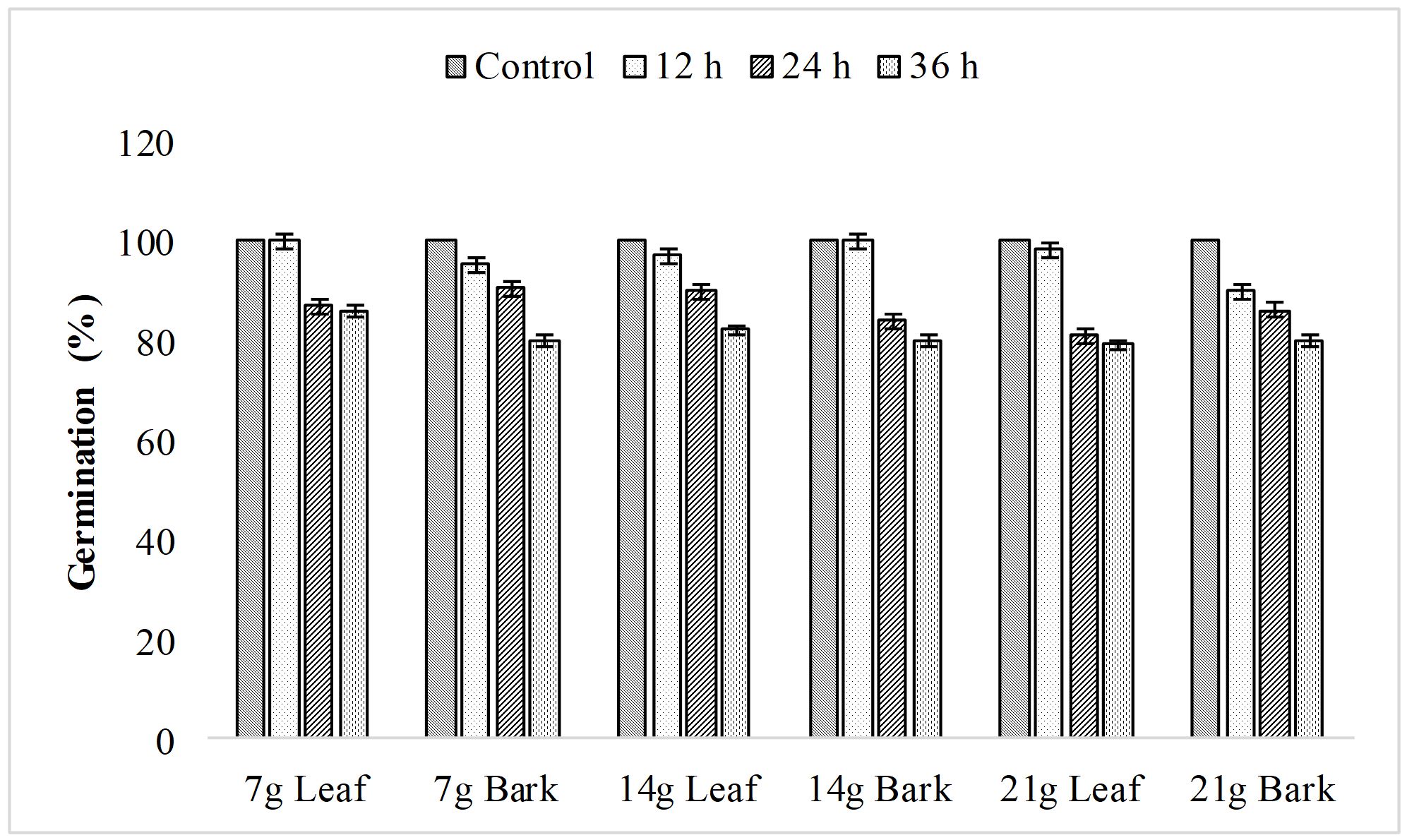
Figure 1 – Germination of wheat under the influence of leaf and bark aqueous extracts of Dalbargia sissoo L.
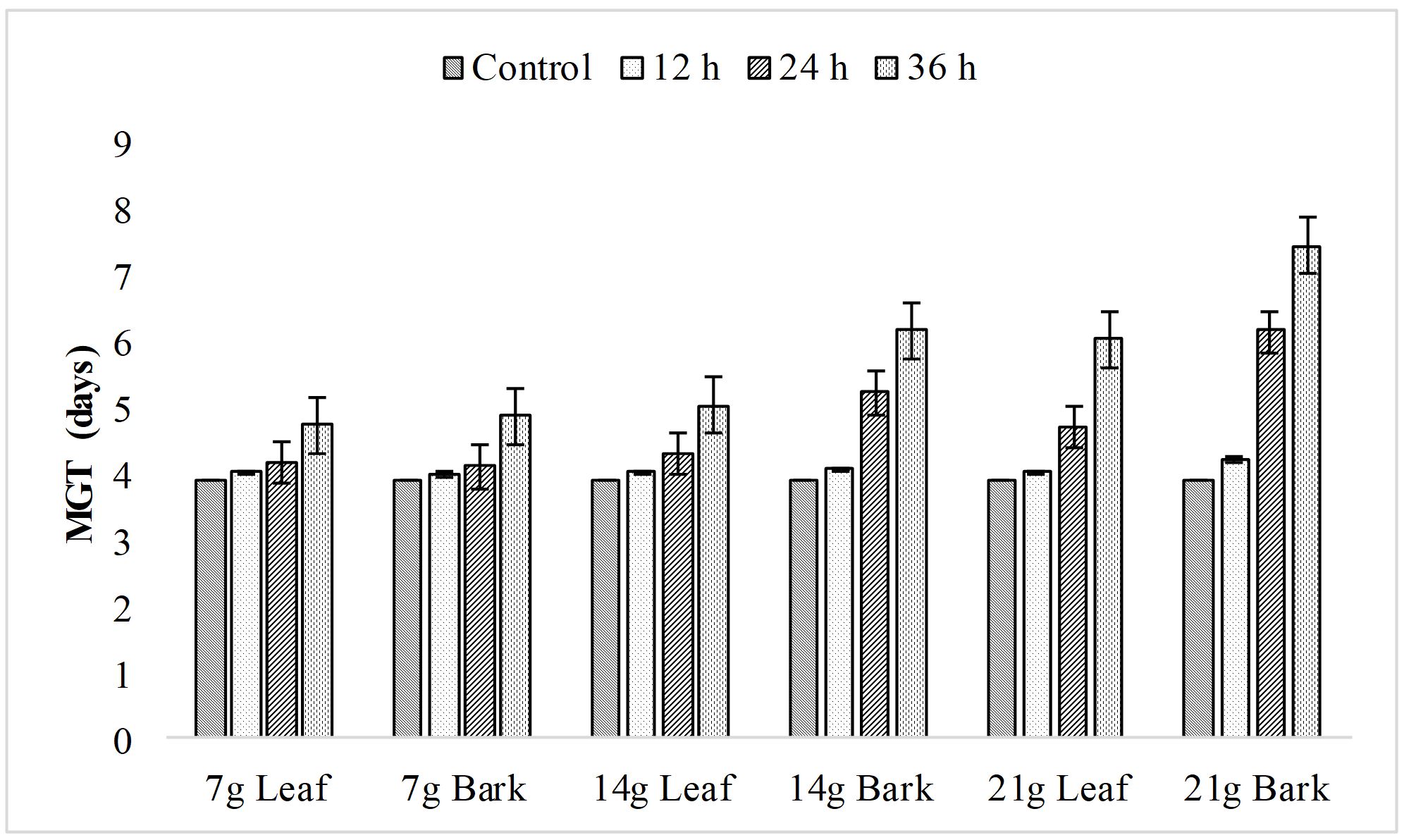
Figure 2 – Effect of leaf and bark aqueous extracts of Dalbargia sissoo L. on mean germination time (MGT) of wheat
Radicle length
In control treatments, radicle length was observed as 18.82 mm, which was slightly, but non-signi-ficantly increased, at 7 g bark extracts soaked for 12 h corresponding to 10.23 mm then decreasing to 17.57 and 17.44 mm under 14 and 21 g leaf extracts, respectively. Significantly lower radicle lengths were observed in 14 and 21 g leaf extracts the same soaking duration, which revealed 9.98 and 9.34 mm radicle lengths, respectively. Except for 7 g leaf extracts, 24 h soaking duration under all concentrations and plant parts had a detrimental effect on radicle length, which ranged between 9.7 and 14.3 mm. Different extract concen-trations of leaf and bark soaked for 36 h significantly suppressed radicle lengths varying between 9.8 and 16.89 mm, except 7 g bark extracts, where it was found as 18.45 mm (Fig. 3).
Seedling dry biomass (mg)
Seedling dry biomass in control treatments was 0.13 mg, which showed both negative and positive responses to different extract concen-trations of leaf and bark soaked for different durations.
In general, leaf and bark extracts concentrations at 12 h soaking period revealed stimulatory effects, except for 21 g leaf extracts, which significantly declined dry biomass (0.08 mg). Similar lethal effects were also found for 7 and 21 g leaf extracts at 24 h soaking duration.
Seedling dry biomass varied between 0.10 and 0.15 mg under the leaf and bark extracts of different concentrations which showed stimulatory influence on the studied parameter (Fig. 4).
Mean germination time (days)
It is apparent from the data presented in Fig. 5 that leaf and bark extracts concentrations and different soaking duration had no stimulatory effects on mean germination time. In control treatments, MGT was recorded 3.9 days, followed by little, but non-significant increases, at 12 h soaking period, where different leaf and bark extracts concentration revealed MGT data, as ranging between 3.98 and 4.2 days. Differential responses were observed at 24 h soaking period where significantly prolonged MGT 5.21 and 6.14 days were found at 14 and 21 g bark extracts, respectively.
Results showed that all concentrations of leaf and bark at 36 h soaking had significantly increased MGT. However, among different concentrations of leaf and bark extracts 21 g bark extract was found the most delaying treatment, which significantly increased MGT up to 7.43 days (Fig. 5).
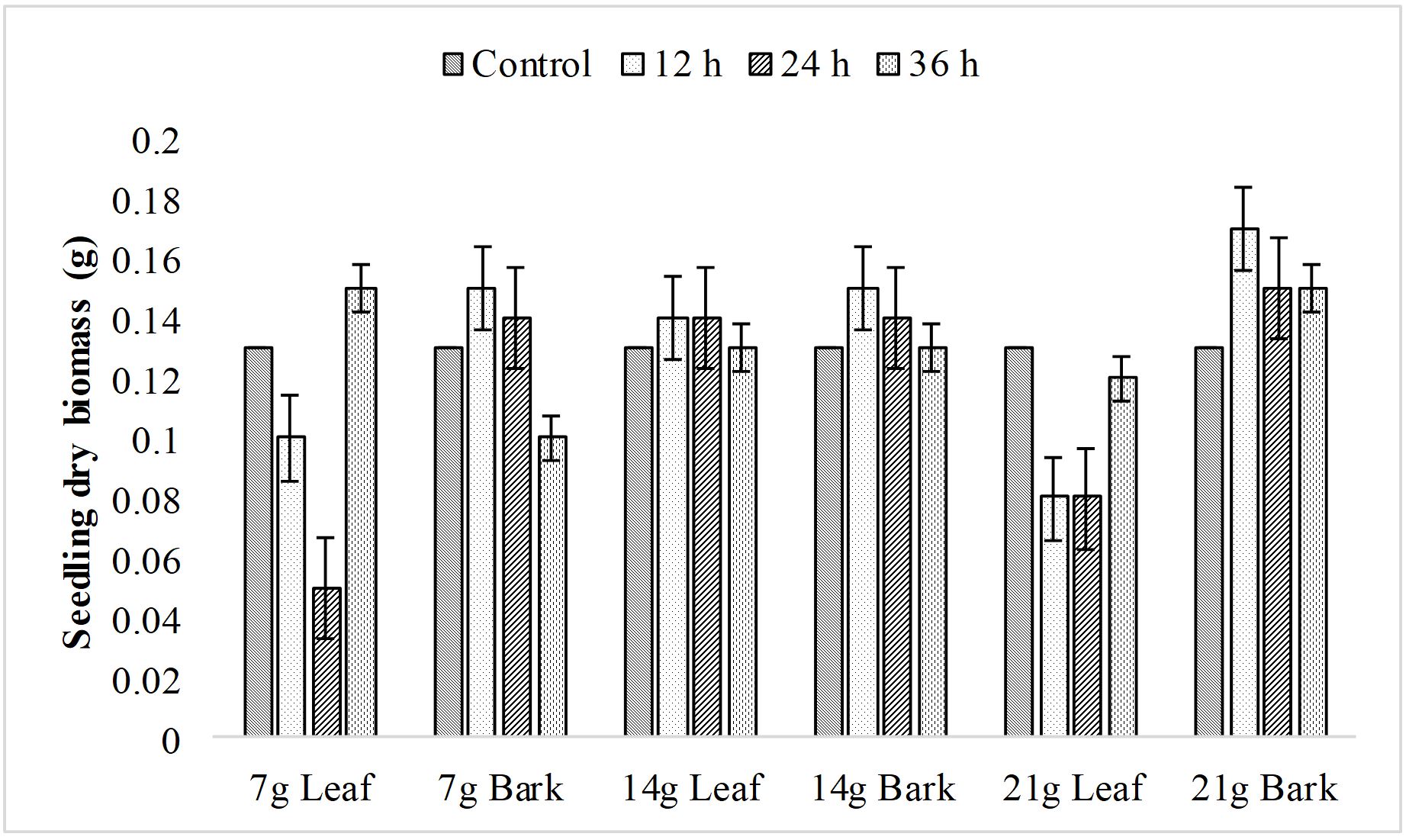
Figure 5 – Seedling dry biomass of wheat under different concentrations and soaking durations of leaf and bark aqueous extracts of Dalbargia sissoo L.
CONCLUSION
Different concentrations of leaf and bark extracts of D. sissoo soaked for 12, 24 and 36 h revealed suppressive allelopathic effects on wheat seed germination, radicle, and plumule lengths and mean germina-tion time but had a positive influence on seedling dry biomass. Bark extracts were more phytotoxic than leaf extracts. Similarly, 14 and 21 g extracts concentration soaked for 36 h exhibited inhibitory allelopathy than lower extracts concentrations and soaking duration. Field studies are suggested to confirm the lab results.
REFERENCES
Abugre, S. & Quashie-Sam, S.J. (2010). Evaluating the allelopathic effect of Jatropha curcas aqueous extract on germination, radicle and plumule length of crops. Int.J.Agric.Biol., 12(5): 769-772.
Aguilera, N., Becerra, J. Villaseňor-Parada, C. Lorenzo, P. González, L. & Hernández, V. (2015). Effects and identification of chemical compounds released from the invasive Acacia dealbata Link. Chem.Ecol., 31(6): 479-493, DOI: 10.1080/02757540.2015.1050004
Ahmed, R., Hoque, A.T.M.R. & Hossain, M.K. (2008). Allelopathic effects of leaf litters of Eucalyptus camaldulensis on some forest and agricultural crops. J.Forest.Res., 19(1): 19-24, DOI: 10.1007/s11676-008-0003-x
Alrababah, M.A., Tadros, M.J., Samarah, N.H. & Ghosheh, H. (2009). Allelopathic effects of Pinus halepensis and Quercus coccifera on the germination of Mediterranean crop seeds. New Forests 38(3): 261-272.
Anonymus (2014). Agricultural Statistics of Pakistan; http://www.pbs.gov.pk /content/agriculture-statistics-pakistan-2013-14.
Asif, M. & Kumar, A. (2011). Phytochemical investigation and evaluation of antinociceptive activity of ethanolic extract of Dalbergia sissoo (Roxb.) bark. J.Nat.Sci.Biol. Med., 2(1): 76-79, DOI: 10.4103/ 0976-9668.82315
Barkatullah, U., Hossain, F. & Ibrar, M. (2010). Allelopathic potential of Dodonaea viscosa (L.) Jacq. Pak.J. Bot., 42(4): 2383-2390.
Braun, H.-J., Atlin, G. & Payne, T. (2010). Multi-location testing as a tool to identify plant response to global climate change. In: Climate Change and Crop Production, M.P. Reynolds (ed.), pp. 115-138. London, UK, CABI
Cantor, A., Hale, A., Aaron, J., Traw, M.B. & Kalisz, S. (2011). Low allelochemical concentrations detected in garlic mustard-invaded forest soils inhibit fungal growth and AMF spore germination. Biol. Invasions, 13(12):3015–3025, DOI:10.1007/s10530-011-9986-x
Fritz, D., Bernardi, A.P., Haas, J.S., Ascoli, B.M., Bordignon, S.A.L. & von Poser, G.L. (2007). Germination and growth inhibitory effects of Hypericum myrianthum and H. polyanthemum extracts on Lactuca sativa L. Rev.Bras. Farmacogn., 17(1): 44-48, DOI: 10. 1590/S0102-695X2007000100010
Hossain, M., Siddique, M.R.H., Rahman, M.S., Hossain, M.Z. & Hasan, M.M. (2011). Nutrient dynamics associ-ated with leaf litter decomposition of three agroforestry tree species (Azadirachta indica, Dalbergia sissoo, and Melia azedarach) of Bangladesh. J.Forest.Res., 22: 577-582.
Inderjit, Wardle, D.A., Karban, R. & Callaway, R.M. (2011). The ecosystem and evolutionary contexts of allelopathy. Trends Ecol.Evol., 26(12) :655-662, DOI: 10.1016/j.tree.2011.08.003
Koul, V.K., Raina, A., Khanna, Y.P., Tickoo, M.L. & Singh, H. (1991). Evaluation of allelopathic influence of certain farm grown tree species on rice (Oryza sativa L. c.v. PC 19). Indian J.For., 14 (1): 54-57.
Lambers, H., Chapin, F.S. & Pons, T.L. (2008). Plant physiological ecology. Springer, New York, DOI: 10.1007/ 978-0-387-78341-3
Majeed, A., Chaudhry, Z. & Muhammad, Z. (2012). Allelopathic assessment of fresh aqueuous extracts of Chenopodium album L. for growth and yield of wheat (Triticum aestivum L.). Pak.J.Bot., 44(1): 165-167.
Majeed, A., Muhammad, Z., Hussain, M. & Ahmad, H. (2017). In vitro allelopathic effect of aqueous extracts of sugarcane on germination parameters of wheat. ActaAgric.Slov., 109(2): 349-356, DOI: 10.14720/aas.2017.109.2.18
Muhammad, Z. & Majeed, A. (2014). Allelopathic effects of aqueous extracts of sunflower on wheat (Triticum aestivum L.) and maize (Zea mays L.). Pak.J.Bot., 46(5): 1715-1718.
Narwal, S.S. (2000). Weed management in rice: wheat rotation by allelopathy. Crit.Rev.Plant Sci., 19(3): 249-266, DOI: 10.1080/07352680091139222
Ngoran, A., Zakra, N., Ballo, K., Kouamé, C., Zapata, F., Hofman, G. & van Cleemput, O. (2006). Litter decomposition of Acacia auriculiformis Cunn. Ex Benth. and Acacia mangium Willd. under coconut trees on quaternary sandy soils in Ivory Coast. Biol.Fert.Soils, 43(1): 102-106.
Oracz, K., Bouteau, H.E.M., Farrant, J.M., Cooper, K., Belghazi, M., Job, C., Job., D., Corbineau, F. & Bailly, C. (2007). ROS production and protein oxidation as a novel mechanism for seed dormancy alleviation. Plant J., 50(3): 452-465, DOI: 10.1111/j.1365-313X.2007. 03063.x
Rao, O., Saxena, A.K. & Singh, B.P. (1994). Allelopathic effects of certain agroforestry tree species on the germination of wheat, paddy and gram. Ann.Forest, 2(1): 60-64.
Seyyednejad, S.M., Koochak, H., Najafabade, F.P. & Kolahi, M. (2010). Allelopathic effect of aquatic hull extract of rice (Oryza sativa L.) on growth of Silybum marianum and Echinochloa crus-galli. Afr.J.Agric. Res., 5: 2222-2226.
Singh, H.P., Kohli, R.K. & Batish, D.R. (1999). Impact of Populus deltoides and Dalbergia sissoo shelterbelts on wheat – a comparative study. Int. Tree Crops J., 10(1): 51-60, DOI: 10.1080/01435698.1999.9752991
Singh, B., Uniyal, A.K., Bhatt, B.P. & Prasad, S. (2006). Effects of agroforestry tree spp. on crops. Allelopathy J., 18(2): 355-361.
Singh, R.P., Hodson, D.P., Huerta-Espino, J., Jin, Y., Bhavani, S., Njau, P. & Govindan, V. (2011). The emergence of Ug99 races of the stem rust fungus is a threat to world wheat production. Ann.Rev. Phytopathol., 49: 465-481, DOI: 10.1146/annurev-phyto-072910-095423
Siyar, S., Chaudhry, Z. & Majeed, A. (2017). Comparative phytotoxicity of aqueous extracts of Centaurea maculosa and Melilotus officinalis on germinability and growth of wheat. Cercet.Agron.Mold., 50(4): 29-35, DOI: 10.1515/cerce-2017-0033
Siyar, S., Majeed, A., Muhammad, Z., Ali, H. & Inayat, N. (2018). Allelopathic effect of aqueous extracts of three weed species on the growth and leaf chlorophyll content of bread wheat. ActaEcol. Sin., DOI: 10.1016/j. chnaes.2018. 05.007
Tanveer, A., Rehman, A., Javaid, M.M., Abbas, R.N., Sibtain, M., Ahmad, A. & Aziz, A. (2010). Allelopathic potential of Euphorbia helioscopia L. against wheat (Triticum aestivum L.), chickpea (Cicer arietinum L.) and lentil (Lens culinaris Medic.). Turk.J.Agric.For., 34: 75-81, DOI: 10.3906/tar-0903-53
Tripathi, S., Tripathi, A., Kori, D.C. & Paroha, S. (2000). Effect of Dalbergio sissoa extracts, rhizobium and nitrogen on germination, growth and yield of Vigna radiata. Allelopathy J., 7(2): 255-264.
Turk, M.A. & Tawaha, A.M. (2003). Allelopathic effect of black mustard (Brassica nigra L.) on germination and growth of wild oat (Avena fatua L.). Crop.Prot., 22(4):673-677, DOI: 10.1016/S0261-2194(02)00241-7
Unal, B.T. (2013). Effects of growth regulators on seed germination, seedling growth and some aspects of metabolism of wheat under allelochemical stress. Bangladesh J.Bot., 42(1): 65-72, DOI: 10.3329/ bjb.v42i1.15865

